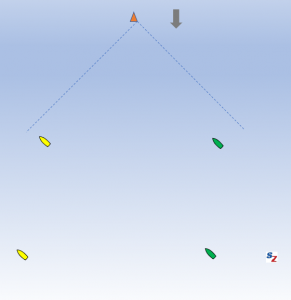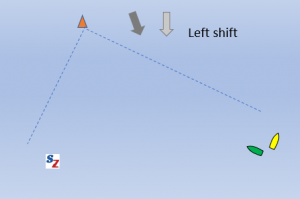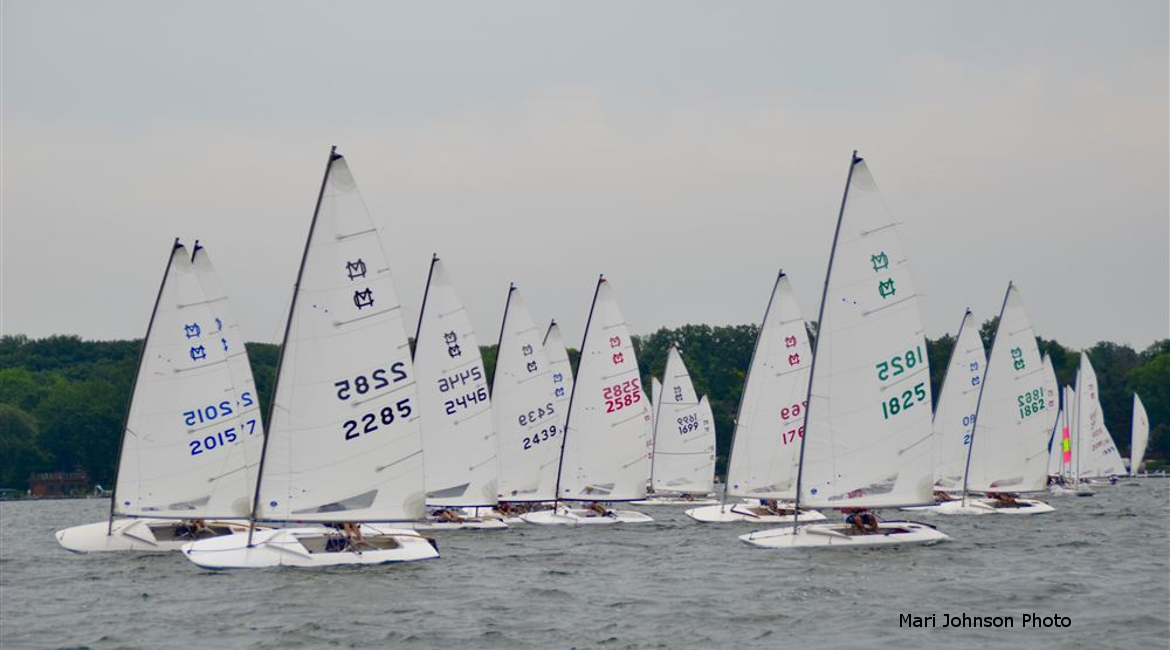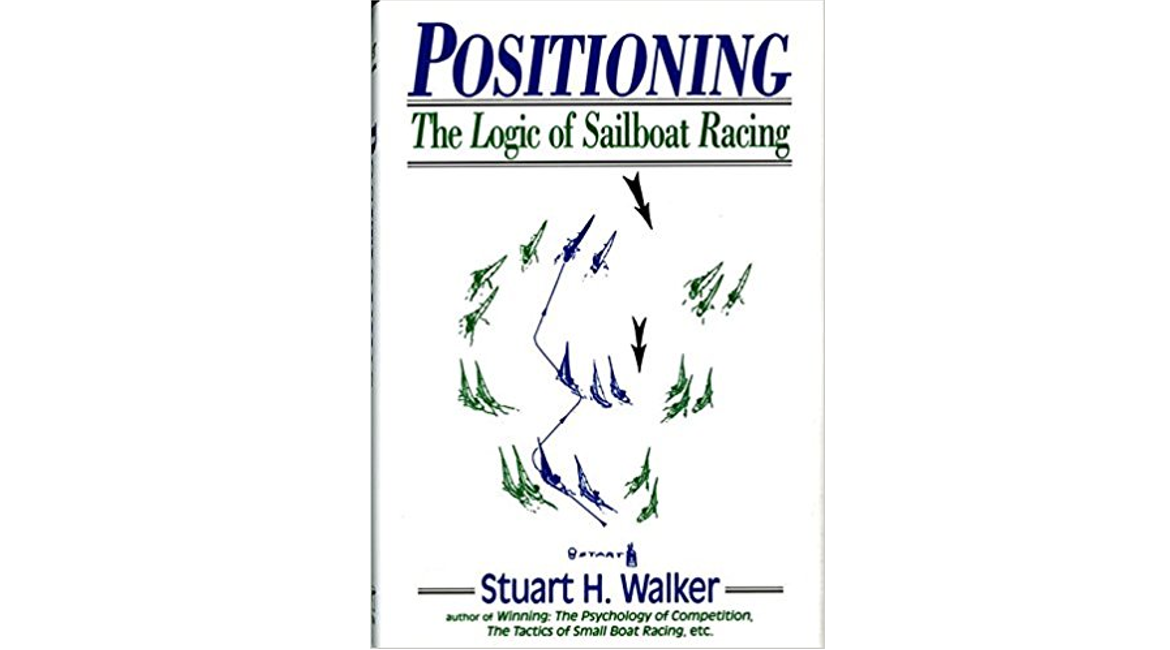Dave Dellenbaugh
My favorite rule of thumb, and one that I have used with great success many times, is to ‘sail the long tack first.’ This is a simple, nearly foolproof guideline that is easy to use and often comes with great results.
There are lots of rules of thumb for upwind strategy. The trick is to know when to use them and when to ignore them. In this article, we look at “sail the long tack” and see how it fits with other upwind strategies.
This article is based on Here’s Why the Long Tack is a Winning Move for Sailors, by Mike Ingham in Sailing World, and sections of Speed and Smarts, Issues 127 and 129, by Dave Dellenbaugh.
What is the Long Tack?
Ingham and Dellenbaugh use slightly different words to define the long tack:
- Ingham: the long tack is the one that points your bow closest to the mark.
- Dellenbaugh: The long tack is the one on which you must spend more time to get from where you are to the mark.
In the drawing to the right, the green boats are on the long tack and the yellow boats are on the short tack. You can see that the two definitions mean the same thing:
- Green’s skipper can see the mark easily off the bow; Yellow’s skipper has to look sideways to see the mark.
- Green can sail on starboard for a longer time than Yellow. Yellow must tack soon or she will go past the layline and sail extra distance.
The Long Tack is Not Always the Lifted Tack
Normally, you think of the lifted tack as the one one that points your bow closest to the mark – just like the long tack. But, as you approach the edges of the course, the lifted tack is not the same as the long tack. In the diagram, the wind has shifted 20 degrees to the left (dark arrow). Yellow is on the lifted tack, but Green is on the long tack.
The Long Tack Keeps You Centered
Ingham puts it this way. “(The long tack) takes you back toward course center. The center of the course is the wind center. It is directly downwind of the weather mark…. It ignores the previous mark and instead only relates to where you are relative to the next mark and the wind direction.”
In the diagrams above. look at the laylines. The laylines define the edges of the course. Note that Green is heading back to the center of the course, while Yellow is heading to the edge.
When it Works
To paraphrase Dellenbaugh, sailing the long tack is no substitute for figuring out what the wind is doing, and developing a strategic plan. However, when you are not so sure about what the wind will do next, it’s a powerful rule of thumb. It works because staying centered gives you more opportunities when the wind might shift in either direction.
The benefits of sailing the long tack are greatest when:
- You are uncertain about the wind. As Dellenbaugh says, if you’re confident about the next shift or puff, forget about the longer tack. If not, sailing the long tack is a good rule of thumb,
- The longer tack is much longer than the short tack. Ingham says at 2:1 (long tack to short), the mark is well over your shoulder and you should start to feel uneasy. At 3:1 you have to all but turn around to see the mark. You had better have a really good reason to keep going into the corner.
- Early and mid-beat. Getting close to the laylines too soon really limits your options, so sailing the long tack is a good way to start. As you get close to the mark, tactics and positioning become more important than sailing the long tack.
How it Fits in the Strategy Mix
Ingham has a nice discussion of how to use this rule of thumb in the context of various conditions.
Oscillating Breeze
In a truly oscillating breeze, with regular shifts around an average direction, you sail the shortest distance by sailing the lifted tack as much as possible. Ideally, you follow this strategy until you get to the last shift before reaching the mark. If this strategy takes you away from the center, the lifted tack and long tack may be different. Ingham says that being “up” (lifted) 10 degrees, with the mark well over your shoulder should make you nervous, and looking for even a small header to tack back.
Randomly Shifty Day
When you can’t find a pattern to the shifts, sailing the long tack might become your primary strategy. Tack on the large headers, but don’t be a slave to your compass. If you’re not pointed at the mark, think about tacking.
One Side Advantaged
If one side is clearly advantaged, due to more wind or a persistent shift, you may end up sailing the short tack first to get to that side. However, once you reach that advantage, continuing further on the short tack becomes much more risky.
Light or Variable Pressure
Ingham describes this situation very well: “We all but ignore the long-tack concept in light wind because sailing to pressure dominates our strategy. Sometimes the winning play will be connecting puffs, other times we will race all the way to a side where we see more wind. Either way, we do not hesitate to take the short tack if it means getting to greater wind velocity.”
Downwind – Sail the Long Gybe
The same principle works for downwind sailing: sail the long gybe first. We’ll cover this more in a future post.Counterpoint – Sailing the Middle is Death
Sailing the long tack keeps you centered in the course. Lots of sailors have told me that on some lakes, you have to pick a side and “send it.” These sailors say that even if you pick the wrong side, you’ll be better off if you win that side than if you stay in the middle.There’s not much written about this. We found an article in Sailing World, in which Stuart Walker makes the point that in medium-length courses, one side of the course is usually advantaged. He says that the advantages of one side or the other only get averaged out in longer courses. We’ll focus on the topic in a future post.
Related Content:
Racing Strategy Choices: Positioning by Stuart Walker – SailZing Book Review
Sailors Helping Sailors
Will you share your knowledge with your related Comments below?







